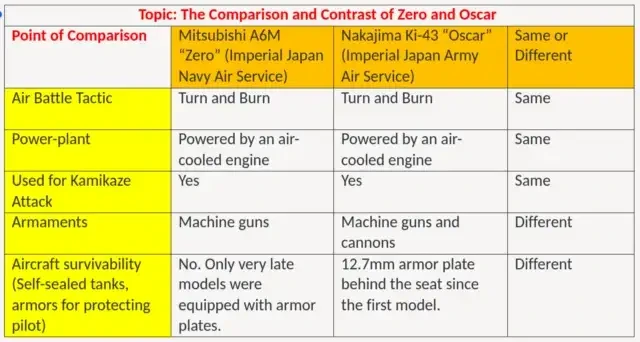Mitsubishi A6M Zero VS Nakajima Ki-43 Oscar.
Introduction#
In 1937, Imperial Japanese Army and Navy invaded China and start to bomb its cities. In the sky, China relied on volunteered pilots from USSR and the US to fight against Japanese aircraft. However, American were shocked by Japanese aircraft, which were very agile, good at dogfighting. The fastest P-40s could not catch them up in turning fights and always got shot down by Japanese fighters, Zero and Hayabusa. The codenames given by Allied forces were “Zeke” and “Oscar”. Zero and Oscar have some similar characteristics, but they also have significant differences.

Please look at the following comparison chart:
Similarities#
One of the similarities between the two aircraft is their air battle tactics. Before the Pacific War, both the Army and the Navy focused on turn-fighting tactics. Due to good battle records of last-generation biplanes in China, pilots preferred agile and light aircraft. It is because that a light and maneuverable aircraft can easily get to enemy aircraft’s six and shoot them down, while the enemy aircraft is hardly to dodge attacks. However, during the diving test of Ki-43, the prototype aircraft disintegrated in the air, so the Army gave up the extreme standard of turning time and strengthened the structure of the aircraft. In comparison, Zero’s designer did not notice the problem above during the test and have the aircraft have many holes on the structure to lighten its weight.
Aircraft Battle Tactic#
Another similarity of these fighters is their design. Because Japanese was good at producing air-cooled engine, few of the aircraft were powered by liquid-cooled engines, which was a mainstream in western countries. Both Zero and Oscar were powered by Nakajima Sakae engine(970 hp). The name differs from code given by the Army and the Navy. The Army called it “Ha-25”, whereas the Navy called it “Sakae”. Though the engine was considered of a copycat of the US Pratt&Whitney R1830 engine, but it was smaller, which is suitable for fighters.
Used for Kamikaze Attack#
Not only the Zeros but the Oscars were used for Kamikaze attacks. After defeat in Philippines, Japanese started asking pilots to do kamikaze, also known as suicide attack. Similarly, Zero and Oscar would carry one to two bombs, get close to US ships and dive into them. Unfortunately, in the late days of the war, Japanese aircraft could not match with the US aircraft due to technology differences. Neither the Army aircraft nor the Navy aircraft could destroy any big ships. Most ships sunk by kamikaze were destroyers and escort aircraft carriers.
Differences#
Despite the similarities in air battle tactics and designs, there are differences between two aircraft. Armaments
One of them is armaments which mounted on the fuselage. Zeros were equipped with two Type 99 20mm cannons on wings and two 7.7 mm machines guns (mg )on cowling. In contrast, Oscar only had two 7.7 mm MGS mounted on the cowling, later upgraded to 12.7mm MGs. Plus, only a prototype Ki-43-III with two 20mm Ho-5 cannons was built. Because of this, Oscar must hit enemy aircraft more to take them down. Additionally, it was impossible for Oscar to intercept U.S. bombers like B-17s or B-29s with his weak guns. However, though 20 mm cannons on Zero were powerful, its muzzle velocity was relatively low, making it hard for pilots to aim and hit targets, so experienced pilots preferred attack enemies with 7.7mm mgs. In short, Zero has better armaments than Oscar, but they were quite bad.
Aircraft survivability#
Zero and Oscar differ from aircraft survivability. In 1939, Jiro Horikoshi, the designer of Zero, was trying to make Zero more agile because he did not have more powerful engine, so he did his best to lighten the structure of the aircraft and have no protecting armor installed. In comparison, due to disintegration during the test, Ki43 designer Hideo Itokawa made the Ki-43 light but has standard strength, and there was a 12.7mm armor plate behind the seat. What is more, unlike early Zero, Oscar did have self-sealing tanks, which could extinguish fire and prevent oil from leaking. But it should be noted that Oscar’s survivability was not that good owing to its tight and small design. According to US pilots’ reports, Oscar might also disintegrate in diving. In short, Oscar had slightly better pilot protection than Zero and almost same body strength.
Conclusion#
In conclusion, Zero and Oscar have many similarities in design and battle tactics. However, the important differences in armaments and survivability should not be ignored. It was interested that Allied pilots always mistaken Oscar for Zero because both of them were very maneuverable, but extremely fragile.